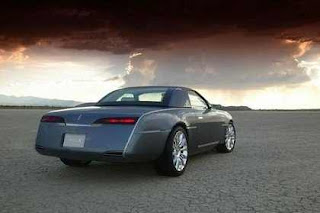
Continental Mark II, 1956-57
The 1956 Lincoln Continental Mark II was unique in its innovative design. Structurally, the Lincoln Continental Mark II chassis combined ladder-type and Y-shape cross-bracing, which made it 30 percent stronger and much more rigid than Lincoln's 1952-1955 X-member frame.

Because the "cowbelly" design meant a relatively higher transmission hump, a special three-joint driveshaft was developed to minimize intrusion.
The low-profile chassis also dictated some suspension differences compared to the 1956 Lincoln, but geometry was the same: coil springs and control arms in front, longitudinal leaf springs at the rear.

Exclusive to the Mark II were special temperature-sensitive shock absorbers, for a smoother ride. Each finished chassis was dynamometer tested and tuned before its body was added. Wheel alignment was held to super-fine tolerances, and wheels, tires, and the power-assisted drum brakes were all carefully balanced.

Attention to detail quality was evident in every phase of Lincoln Continental Mark II assembly. Consider the care involved with just the painting. First, the supporting structure and all body panels were fitted on a simulated chassis, then removed. After the body was surface-sealed, a primer coat was applied, water-sanded by hand, then baked.

Next came a surfacer coat with another hand sanding and baking, followed by two lacquer color coats that were oil-sanded by hand, then baked. Finally, two more lacquer coats were applied and baked, followed by a thorough hand-buffing and polishing.

Similar care was lavished in places where most customers would never think to look. Chrome plating exceeded SAE specification by a factor of three. Nuts and bolts were near-aircraft quality, and some were chromed.
Door end panels and door jambs were plated in hard chrome and screwed into place, and chrome was used even on stainless-steel trim. The Mark II was chromed where it counted, not necessarily where it showed.
This obsession with perfection partly explains why the Mark II was offered in just a single body style, a hardtop coupe, and with only one driveline. Buyers had a wide choice of exterior colors, but there were no pinks, aquamarines, or other shocking 1950's favorites. There were no two-tones, either, and they would have been out of place anyway.

From any angle, the Mark II was exceptionally elegant for this flamboyant era: clean, dignified without being stuffy and, most important, thoroughly evocative of its 1940-1941 ancestor.

Though its long-hood/short-deck proportions weren't as pronounced, it did have the same sort of close-coupled appearance. And it maintained tradition with a trunk-lid styled to resemble the familiar "continental" spare tire.
Source: Internet
 Lincoln’s first two-door convertible concept with a power-folding, retractable, glass-roofed hardtop is the Mark X. Pronounced "Mark Ten," the two-seat luxury convertible roadster is based on the rear-wheel-drive Ford Thunderbird architecture, and features a 280 horsepower, 3.9-liter, 4-valve DOHC V-8 aluminum engine mated to a five-speed automatic transmission. Mark X’s SelectShift transmission allows the driver to shift from manual drive to a five-speed automatic from the steering wheel or shifter in the center console. A multi-functional, 7-inch LCD information panel is operated by a mouse located in the center console and displays satellite navigation, climate control status and vehicle dynamics like seat memory or tire pressure.
Lincoln’s first two-door convertible concept with a power-folding, retractable, glass-roofed hardtop is the Mark X. Pronounced "Mark Ten," the two-seat luxury convertible roadster is based on the rear-wheel-drive Ford Thunderbird architecture, and features a 280 horsepower, 3.9-liter, 4-valve DOHC V-8 aluminum engine mated to a five-speed automatic transmission. Mark X’s SelectShift transmission allows the driver to shift from manual drive to a five-speed automatic from the steering wheel or shifter in the center console. A multi-functional, 7-inch LCD information panel is operated by a mouse located in the center console and displays satellite navigation, climate control status and vehicle dynamics like seat memory or tire pressure.



































_01.jpg)
_03.jpg)
_04.jpg)











